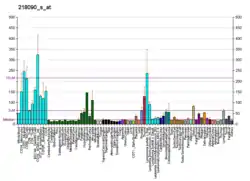WD repeat-containing protein 11
WD repeat-containing protein 11 (WDR11) also known as bromodomain and WD repeat-containing protein 2 (BRWD2) is a protein that in humans is encoded by the WDR11 gene.[5][6][7]
Function
This gene encodes a member of the WD repeat protein family. WD repeats are minimally conserved regions of approximately 40 amino acids typically bracketed by gly-his and trp-asp (GH-WD), which may facilitate formation of heterotrimeric or multiprotein complexes. Members of this family are involved in a variety of cellular processes, including cell cycle progression, signal transduction, apoptosis, and gene regulation.[7]
Clinical significance
This gene is located in the chromosome 10q25-26 region, which is frequently deleted in gliomas and tumors of other tissues, and is disrupted by the t(10;19) translocation rearrangement in glioblastoma cells. The gene location suggests that it is a candidate gene for the tumor suppressor locus.[7]
References
- GRCh38: Ensembl release 89: ENSG00000120008 - Ensembl, May 2017
- GRCm38: Ensembl release 89: ENSMUSG00000042055 - Ensembl, May 2017
- "Human PubMed Reference:". National Center for Biotechnology Information, U.S. National Library of Medicine.
- "Mouse PubMed Reference:". National Center for Biotechnology Information, U.S. National Library of Medicine.
- Nagase T, Kikuno R, Ishikawa KI, Hirosawa M, Ohara O (Apr 2000). "Prediction of the coding sequences of unidentified human genes. XVI. The complete sequences of 150 new cDNA clones from brain which code for large proteins in vitro". DNA Res. 7 (1): 65–73. doi:10.1093/dnares/7.1.65. PMID 10718198.
- Chernova OB, Hunyadi A, Malaj E, Pan H, Crooks C, Roe B, Cowell JK (Sep 2001). "A novel member of the WD-repeat gene family, WDR11, maps to the 10q26 region and is disrupted by a chromosome translocation in human glioblastoma cells". Oncogene. 20 (38): 5378–92. doi:10.1038/sj.onc.1204694. PMID 11536051.
- "Entrez Gene: BRWD2 bromodomain and WD repeat domain containing 2".
Further reading
- Katoh M, Katoh M (2003). "Recombination cluster around FGFR2-WDR11-HTPAPL locus on human chromosome 10q26". Int. J. Mol. Med. 11 (5): 579–83. doi:10.3892/ijmm.11.5.579. PMID 12684693.
- Katoh M, Katoh M (2003). "FGFR2 and WDR11 are neighboring oncogene and tumor suppressor gene on human chromosome 10q26". Int. J. Oncol. 22 (5): 1155–9. doi:10.3892/ijo.22.5.1155. PMID 12684685.




